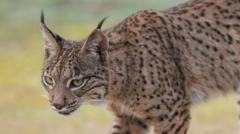The Iberian lynx, known for its distinctive leopard-like spots and captivating presence, is slowly making a comeback from near extinction. With over 2,000 individuals now roaming the wilds of Spain and Portugal, the iconic feline is becoming a more common sight than it was just 20 years ago. "The Iberian lynx was very, very close to extinction," says Rodrigo Serra, who leads the reproductive program across both countries. At the population's lowest point, fewer than 100 lynxes remained, with just 25 capable of reproduction. Historical comparisons amplify the urgency, as the lynx faced threats akin to those that led to the extinction of species like the saber-toothed tiger.
The dramatic decline of the lynx can be attributed to extensive land conversion for agriculture, rising road fatalities, and prey scarcity due to rabbit pandemics that decimated populations by 95%. By 2005, Portugal was devoid of wild lynxes, the same year Spain celebrated its first successful captive breeding. Subsequently, Portugal initiated a national conservation plan, culminating in the establishment of a National Breeding Centre for Iberian lynxes in Silves, Algarve, where the animals are under constant observation. The center aims not only to prepare lynxes for reintroduction into the wild but also to facilitate their breeding.
Serra emphasizes the delicate balance between socialization and training within the breeding program. To help lynxes maintain their wild instincts, they create controlled stress scenarios, teaching them to avoid human interaction. Food is provided through a bunker-like tunnel system to prevent any reliance on humans. Importantly, when the time comes for their release, genetics guide the location choices to minimize inbreeding risks.
Pedro Sarmento, responsible for reintroducing lynxes in Portugal, notes their unique physical traits—small heads and broad paws—that equip them for effective hunting and mobility. While their recovery is often celebrated as a conservation victory, challenges remain. Coordinating with private landowners for lynx releases is essential, and there are concerns over livestock attacks, although such incidents have been minimal.
One notable story is that of Lítio, one of the earliest lynxes released. Initially, he was tracked within a specific range before he went unseen for several months. Ultimately, he returned to Doñana National Park in Spain for care before being re-released locally. Lítio's tenacity paid off as he found a mate and became a progenitor of many lynx cubs.
With conservationists now able to observe the species thriving in their natural habitat, Serra remains hopeful for the future. He envisions a population target of 5,000-6,000 lynxes to secure their conservation status by 2035. Yet they continue to face threats, particularly from roads, which accounted for 80% of lynx mortality last year. Despite the hurdles, the Iberian lynx's journey from the brink of extinction to a state of recovery marks a crucial chapter in wildlife conservation efforts in Spain and Portugal.





















